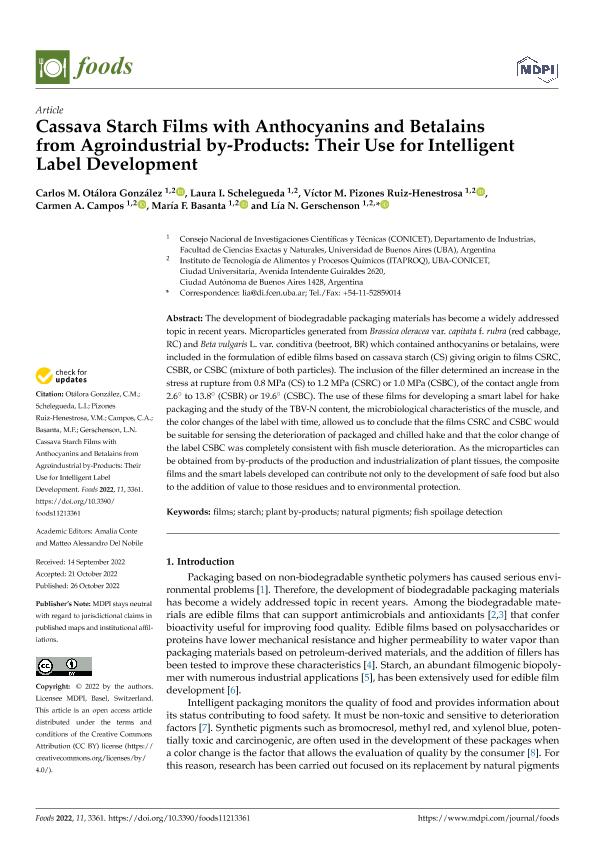Artículo
Cassava Starch Films with Anthocyanins and Betalains from Agroindustrial by-Products: Their Use for Intelligent Label Development
Otálora González, Carlos Mauricio ; Schelegueda, Laura Inés
; Schelegueda, Laura Inés ; Pizones Ruiz Henestrosa, Víctor Manuel
; Pizones Ruiz Henestrosa, Víctor Manuel ; Campos, Carmen Adriana
; Campos, Carmen Adriana ; Basanta, Maria Florencia
; Basanta, Maria Florencia ; Gerschenson, Lia Noemi
; Gerschenson, Lia Noemi
 ; Schelegueda, Laura Inés
; Schelegueda, Laura Inés ; Pizones Ruiz Henestrosa, Víctor Manuel
; Pizones Ruiz Henestrosa, Víctor Manuel ; Campos, Carmen Adriana
; Campos, Carmen Adriana ; Basanta, Maria Florencia
; Basanta, Maria Florencia ; Gerschenson, Lia Noemi
; Gerschenson, Lia Noemi
Fecha de publicación:
10/2022
Editorial:
MDPI
Revista:
Foods
ISSN:
2304-8158
Idioma:
Inglés
Tipo de recurso:
Artículo publicado
Clasificación temática:
Resumen
The development of biodegradable packaging materials has become a widely addressed topic in recent years. Microparticles generated from Brassica oleracea var. capitata f. rubra (red cabbage, RC) and Beta vulgaris L. var. conditiva (beetroot, BR) which contained anthocyanins or betalains, were included in the formulation of edible films based on cassava starch (CS) giving origin to films CSRC, CSBR, or CSBC (mixture of both particles). The inclusion of the filler determined an increase in the stress at rupture from 0.8 MPa (CS) to 1.2 MPa (CSRC) or 1.0 MPa (CSBC), of the contact angle from 2.6° to 13.8° (CSBR) or 19.6° (CSBC). The use of these films for developing a smart label for hake packaging and the study of the TBV-N content, the microbiological characteristics of the muscle, and the color changes of the label with time, allowed us to conclude that the films CSRC and CSBC would be suitable for sensing the deterioration of packaged and chilled hake and that the color change of the label CSBC was completely consistent with fish muscle deterioration. As the microparticles can be obtained from by-products of the production and industrialization of plant tissues, the composite films and the smart labels developed can contribute not only to the development of safe food but also to the addition of value to those residues and to environmental protection.
Palabras clave:
FILMS
,
FISH SPOILAGE DETECTION
,
NATURAL PIGMENTS
,
PLANT BY-PRODUCTS
,
STARCH
Archivos asociados
Licencia
Identificadores
Colecciones
Articulos(ITAPROQ)
Articulos de INSTITUTO DE TECNOLOGIA DE ALIMENTOS Y PROCESOS QUIMICOS
Articulos de INSTITUTO DE TECNOLOGIA DE ALIMENTOS Y PROCESOS QUIMICOS
Citación
Otálora González, Carlos Mauricio; Schelegueda, Laura Inés; Pizones Ruiz Henestrosa, Víctor Manuel; Campos, Carmen Adriana; Basanta, Maria Florencia; et al.; Cassava Starch Films with Anthocyanins and Betalains from Agroindustrial by-Products: Their Use for Intelligent Label Development; MDPI; Foods; 11; 21; 10-2022; 1-11
Compartir
Altmétricas



